Multipath TCP-Based IoT Communication Evaluation: From the Perspective of Multipath Management with Machine Learning
Abstract
1. Introduction
2. Background and Related Work
3. Design Overview of ALPS-MPTCP
3.1. k-Nearest Neighbor Algorithm(k-NN)
3.2. Random Forest Algorithm
3.3. k-Means Clustering Algorithm(k-Means)
3.4. Reinforcement Learning Algorithm
4. Performance Evaluation
4.1. Experimental Setup
- (i)
- A wired server, located in JXNU (Jiangxi Normal University), the operating system is Fedora Core 6, the kernel version is 2.6.15. The server is connected to the JXNU network through the Ethernet interface;
- (ii)
- Two mobile clients, that is, two Android smartphones as the client of the Skype voice call. We have introduced machine learning into MPTCP path management at the application layer, taking advantage of portability and convenience of access to a variety of information from wireless networks and mobile devices. The pre-built random forest algorithm, reinforcement learning algorithm, k-Means algorithm, and k-NN algorithm are embedded in the measurement application. In the simulation experiment, we used the characteristic parameters of LTE and Wi-Fi networks provided by the International Telecommunication Union (ITU), including fixed broadband values and interval values of delay and packet loss rate [31]. In order to ensure the fairness of the experiment, a wireless routing node was set up on each mobile device, and the two wireless routers used the same bandwidth. We generated random numbers within the parameter range to simulate various path environments.
4.2. Performance under the k-NN Algorithm
4.3. Performance under the Random Forest Algorithm
4.4. Performance under the k-Means Algorithms
4.5. Performance under the Reinforcement Learning Algorithms
4.6. Performance Comparison of Different Algorithms
5. Conclusions and Future Work
Author Contributions
Funding
Conflicts of Interest
References
- Song, F.; Zhu, M.; Zhou, Y.; You, I.; Zhang, H. Smart Collaborative Tracking for Ubiquitous Power IoT in Edge-Cloud Interplay Domain. IEEE Internet Things J. 2020, 7, 6046–6055. [Google Scholar] [CrossRef]
- Wu, J.; Cheng, B.; Wang, M. Improving Multipath Video Transmission with Raptor Codes in Heterogeneous Wireless Networks. IEEE Trans. Multimed. 2018, 20, 457–472. [Google Scholar] [CrossRef]
- Song, F.; Ai, Z.; Zhou, Y.; You, I.; Choo, R.; Zhang, H. Smart Collaborative Automation for Receive Buffer Control in Multipath Industrial Networks. IEEE Trans. Ind. Inform. 2020, 16, 1385–1394. [Google Scholar] [CrossRef]
- Ford, A.; Raiciu, C.; Handley, M.; Bonaventure, O. TCP Extensions for Multipath Operation with Multiple Addresses. IETF RFC 2013, 6824. [Google Scholar] [CrossRef]
- Xue, K.; Chen, K.; Ni, D.; Zhang, H.; Hong, P. Survey of MPTCP-based Multipath Transmission Optimization. Comput. Res. Dev. 2016, 53, 2512–2529. [Google Scholar] [CrossRef]
- Saha, S.; Aggarwal, S.; Pathak, R.; Koutsonikolas, D.; Widmer, J. AMuSe: An Agile Multipath-TCP Scheduler for Dual-Band 802.11ad/ac Wireless LANs. In Proceedings of the 25th Annual International Conference on Mobile Computing and Networking, Los Cabos, Mexico, 21–25 October 2019; pp. 1–16. [Google Scholar] [CrossRef]
- Kimura, B.Y.L.; Lima, D.C.S.F.; Villas, L.A.; Loureiro, A.A.F. Interpath contention in MultiPath TCP disjoint paths. IEEE/ACM Trans. Netw. 2019, 27, 1387–1400. [Google Scholar] [CrossRef]
- Saraiva, D.A.F.; Leithardt, V.R.Q.; de Paula, D.; Mendes, A.S.; Gonz, G.V.; Crocker, P. PRISEC: Comparison of Symmetric Key Algorithms for IoT Devices. Sensors 2019, 19, 4312. [Google Scholar] [CrossRef]
- Yin, X.; Liu, J.; Cheng, X.; Zeng, B.; Xiong, X. A low-complexity design for the terminal device of the urban IoT-oriented heterogeneous network with ultra-high-speed OFDM processing. Sustain. Cities Soc. 2020, 61. [Google Scholar] [CrossRef]
- Shafiq, M.; Le, F.; Srivatsa, M.; Liu, A. Cross-path inference attacks on multipath TCP. In Proceedings of the ACM Workshop on Hot Topics in Networks, College Park, MD, USA, 21–22 November 2013; pp. 1–7. [Google Scholar] [CrossRef]
- Li, M.; Lukyanenko, A.; Tarkoma, S.; Cui, Y.; Yla-Jaaski, A. Tolerating path heterogeneity in multipath TCP with bounded receive buffers. ACM Sigmetrics Perform. Eval. Rev. 2013, 41, 375–376. [Google Scholar] [CrossRef]
- Cao, Y.; Song, F.; Liu, Q.; Huang, M.; Wang, H.; You, I. A LDDoS-aware energy-efficient multipathing scheme for mobile cloud computing systems. IEEE Access 2017, 5, 21862–21872. [Google Scholar] [CrossRef]
- Song, F.; Zhou, Y.; Wang, Y.; Zhao, T.; You, I.; Zhang, H. Smart collaborative distribution for privacy enhancement in moving target defense. Inf. Sci. 2018, 479, 593–606. [Google Scholar] [CrossRef]
- Paasch, C.; Bonaventure, O. Securing the Multipath TCP Handshake with External Keys. In Proceedings of the IEEE EUROCON 2017—17th International Conference on Smart Technologies, Ohrid, Macedonia, 6–8 July 2017; pp. 954–959. [Google Scholar] [CrossRef]
- Oh, B.; Lee, J. Feedback-based path failure detection and buffer blocking protection for MPTCP. IEEE/ACM Trans. Netw. 2016, 24, 3450–3461. [Google Scholar] [CrossRef]
- Cao, Y.; Collotta, M.; Xu, S.; Huang, L.; Tao, X.; Zhou, Z. Towards adaptive multipath managing: A lightweight path management mechanism to aid multihomed mobile computing devices. Appl. Sci. 2020, 10, 380. [Google Scholar] [CrossRef]
- Available online: https://www.hjp.at/doc/rfc/rfc6298.html (accessed on 12 November 2020). [CrossRef]
- Cao, Y.; Chen, S.; Liu, Q.; Zuo, Y.; Wang, H.; Huang, M. QoE-driven Energy-aware Multipath Content Delivery Approach for MPTCP-based Mobile Phones. China Commun. 2017, 14, 90–103. [Google Scholar] [CrossRef]
- Cao, Y.; Chen, J.; Liu, Q.; Lei, G.; Wang, H.; You, I. Can Multipath TCP Be Robust to Cyber Attacks with Incomplete Information. IEEE Access 2020, 8, 165872–165883. [Google Scholar] [CrossRef]
- Lim, Y.; Chen, Y.; Nahum, E.; Towsley, D.; Lee, K. Cross layer path management in multipath transport protocol for mobile devices. In Proceedings of the IEEE INFOCOM 2014—IEEE Conference on Computer Communications, Toronto, ON, Canada, 27 April–2 May 2014. [Google Scholar] [CrossRef]
- Hesmans, B.; Detal, G.; Bauduin, R.; Bonaventure, O. SMAPP: Towards Smart Multipath TCP-enabled Applications. In Proceedings of the ACM Conference on Emerging Networking Experiments and Technologies, Heidelberg, Germany, 1–4 December 2015; pp. 1–7. [Google Scholar]
- Chaturvedi, R.K.; Chand, S. An Adaptive and Efficient Packet Scheduler for Multipath TCP. Iran. J. Sci. Technol. Trans. Electr. Eng. 2020. [Google Scholar] [CrossRef]
- Chung, J.; Han, D.; Kim, J.; Kim, C. Machine learning based path management for mobile devices over MPTCP. In Proceedings of the IEEE International Conference on Big Data and Smart Computing, Jeju, Korea, 13–16 February 2017; pp. 206–209. [Google Scholar] [CrossRef]
- Li, W.; Zhang, H.; Gao, S.; Xue, C.; Wang, X.; Lu, S. SmartCC: A Reinforcement Learning Approach for Multipath TCP Congestion Control in Heterogeneous Networks. IEEE J. Sel. Areas Commun. 2019, 37, 2621–2633. [Google Scholar] [CrossRef]
- Xu, Z.; Tang, J.; Yin, C.; Wang, Y.; Xue, G. Experience-Driven Congestion Control: When multipath TCP Meets Deep Reinforcement Learning. IEEE J. Sel. Areas Commun. 2019, 37, 1325–1336. [Google Scholar] [CrossRef]
- Polese, M.; Chiariotti, F.; Bonetto, E.; Rigotto, F.; Zanella, A.; Zorzi, M. A Survey on Recent Advances in Transport Layer Protocols. IEEE Commun. Surv. Tutor. 2019, 21, 3584–3608. [Google Scholar] [CrossRef]
- Cover, T.; Hart, P. Nearest neighbor pattern classification. IEEE Trans. Inf. Theory 1967, 13, 21–27. [Google Scholar] [CrossRef]
- Amit, Y.; Donald, G. Shape Quantization And Recognition with Randomized Trees. Neural Comput. 1997, 9, 1545–1588. [Google Scholar] [CrossRef]
- Hartigan, J.; Wong, M. Algorithm AS 136: A K-Means Clustering Algorithm. J. R. Stat. Soc. Ser. C (Appl. Stat.) 1979, 28, 100–108. [Google Scholar] [CrossRef]
- Fenza, G.; Orciuoli, F.; Sampson, D.G. Building Adaptive Tutoring Model Using Artificial Neural Networks and Reinforcement Learning. In Proceedings of the IEEE 17th International Conference on Advanced Learning Technologies, Timisoara, Romania, 3–7 July 2017; pp. 460–462. [Google Scholar] [CrossRef]
- International Telecommunication Union (ITU). ITU-R Recommendations. Available online: https://www.itu.int/pub/R-REC (accessed on 12 January 2020).
- Manjusha, M.; Harikumar, R. Performance analysis of k-NN classifier and K-means clustering for robust classification of epilepsy from EEG signals. In Proceedings of the International Conference on Wireless Communications, Signal Processing and Networking, Chennai, India, 23–25 March 2016; pp. 2412–2416. [Google Scholar] [CrossRef]
- Jin, M.; Govindarajan, L.N.; Cheng, L. A random-forest random field approach for cellular image segmentation. In Proceedings of the IEEE 11th International Symposium on Biomedical Imaging, Beijing, China, 29 April–2 May 2014; pp. 1251–1254. [Google Scholar] [CrossRef]
- Song, F.; Ai, Z.; Zhang, H.; You, I.; Li, S. Smart Collaborative Balancing for Dependable Network Components in Cyber-Physical Systems. IEEE Trans. Ind. Inform. 2020. [Google Scholar] [CrossRef]
- Song, F.; Zhou, Y.; Chang, L.; Zhang, H. Modeling Space-Terrestrial Integrated Networks with Smart Collaborative Theory. IEEE Netw. 2019, 33, 51–57. [Google Scholar] [CrossRef]
- Yi, Y.; Shi, Y.; Wang, W.; Lei, G.; Dai, J.; Zheng, H. Combining Boundary Detector and SND-SVM for Fast Learning. Int. J. Mach. Learn. Cybern. 2020, 1–10. [Google Scholar] [CrossRef]
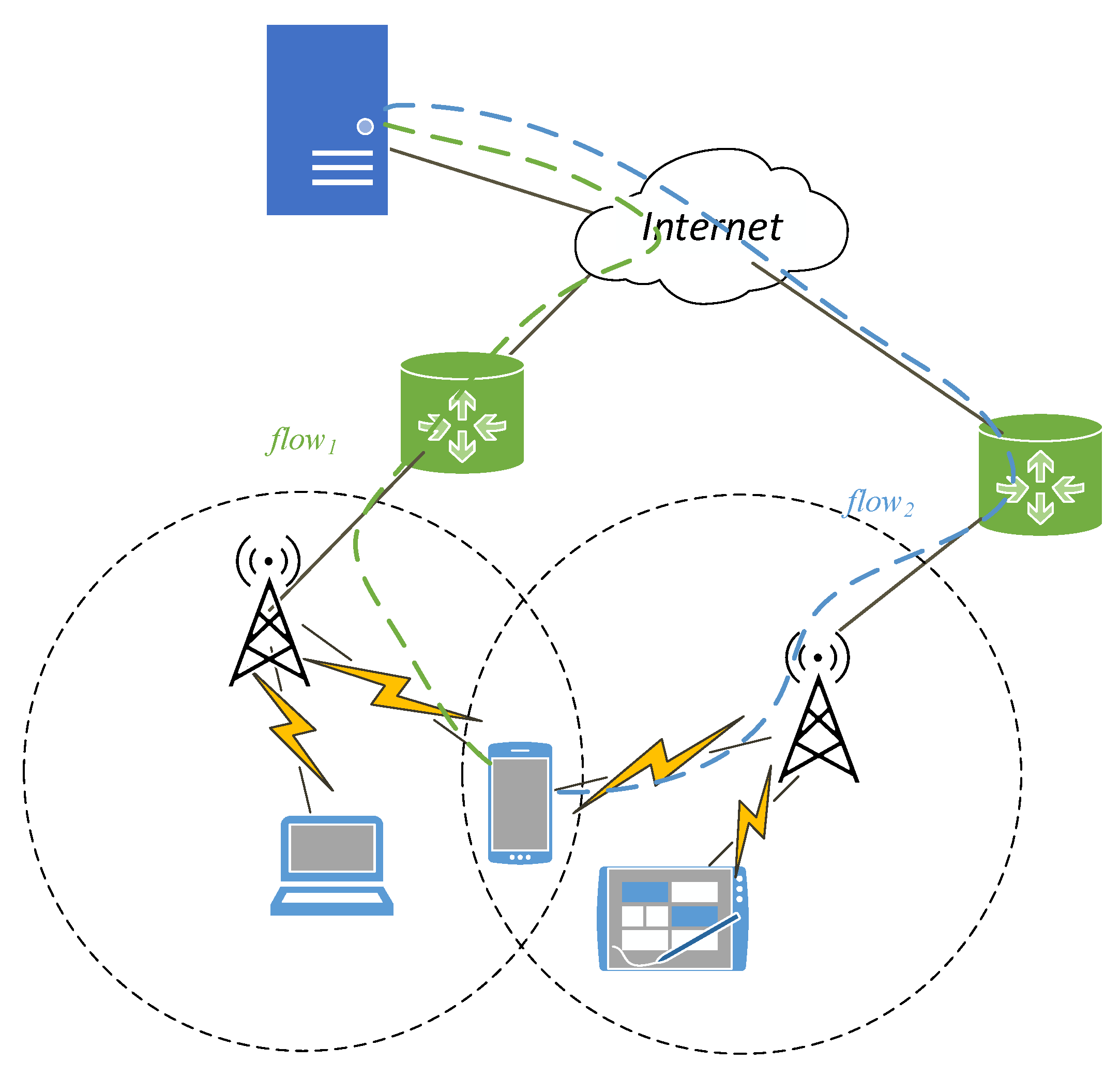
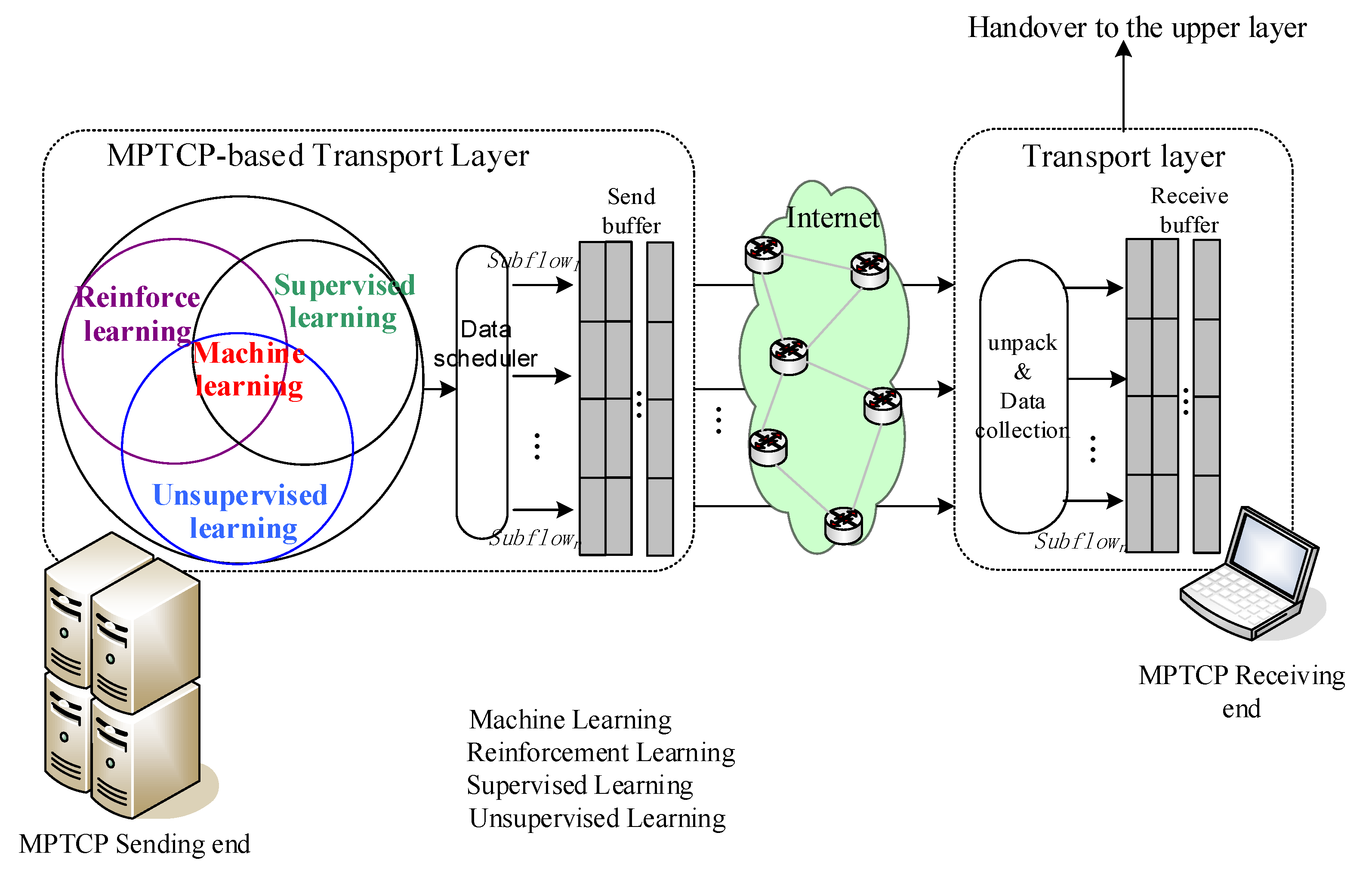
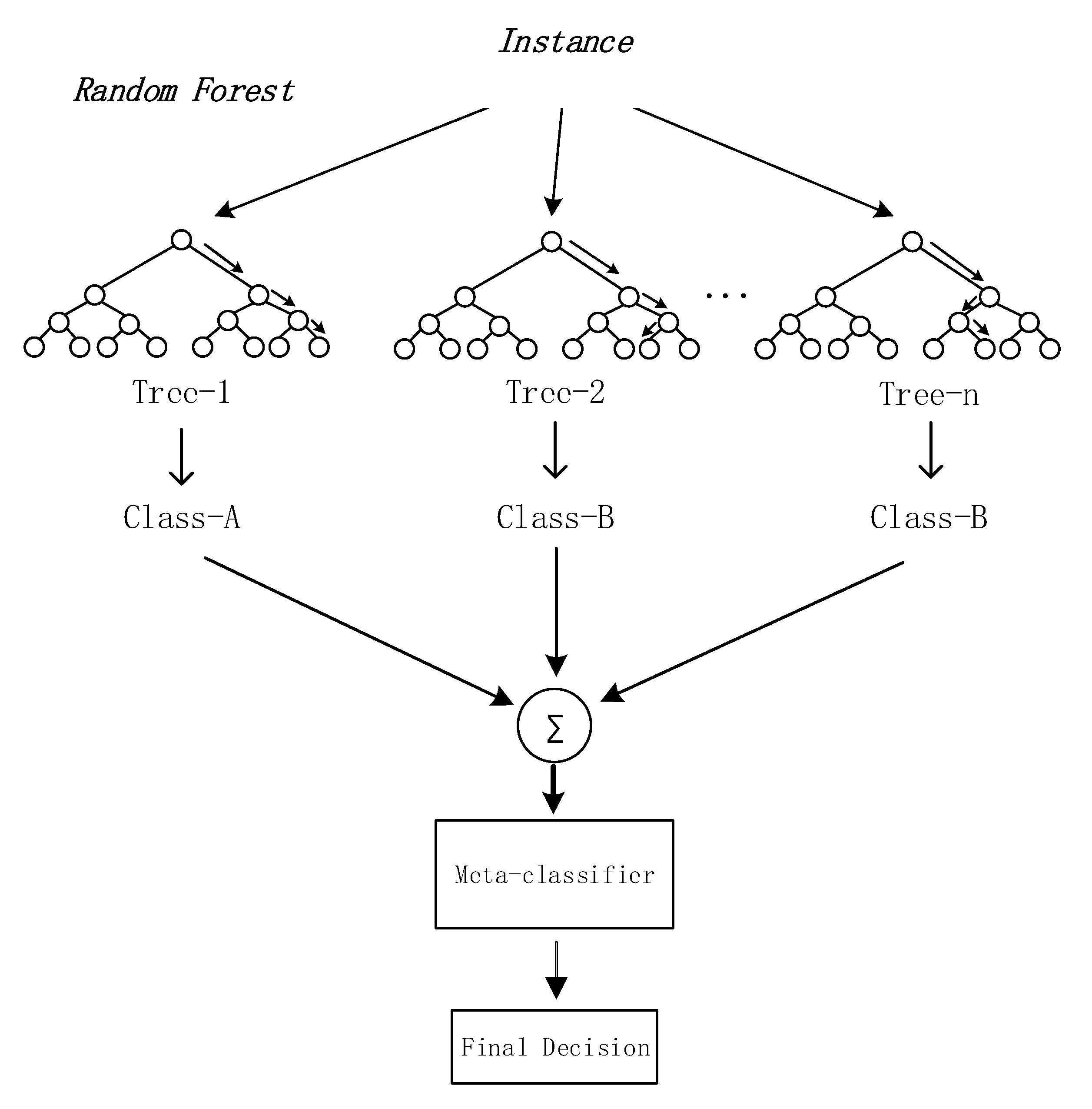

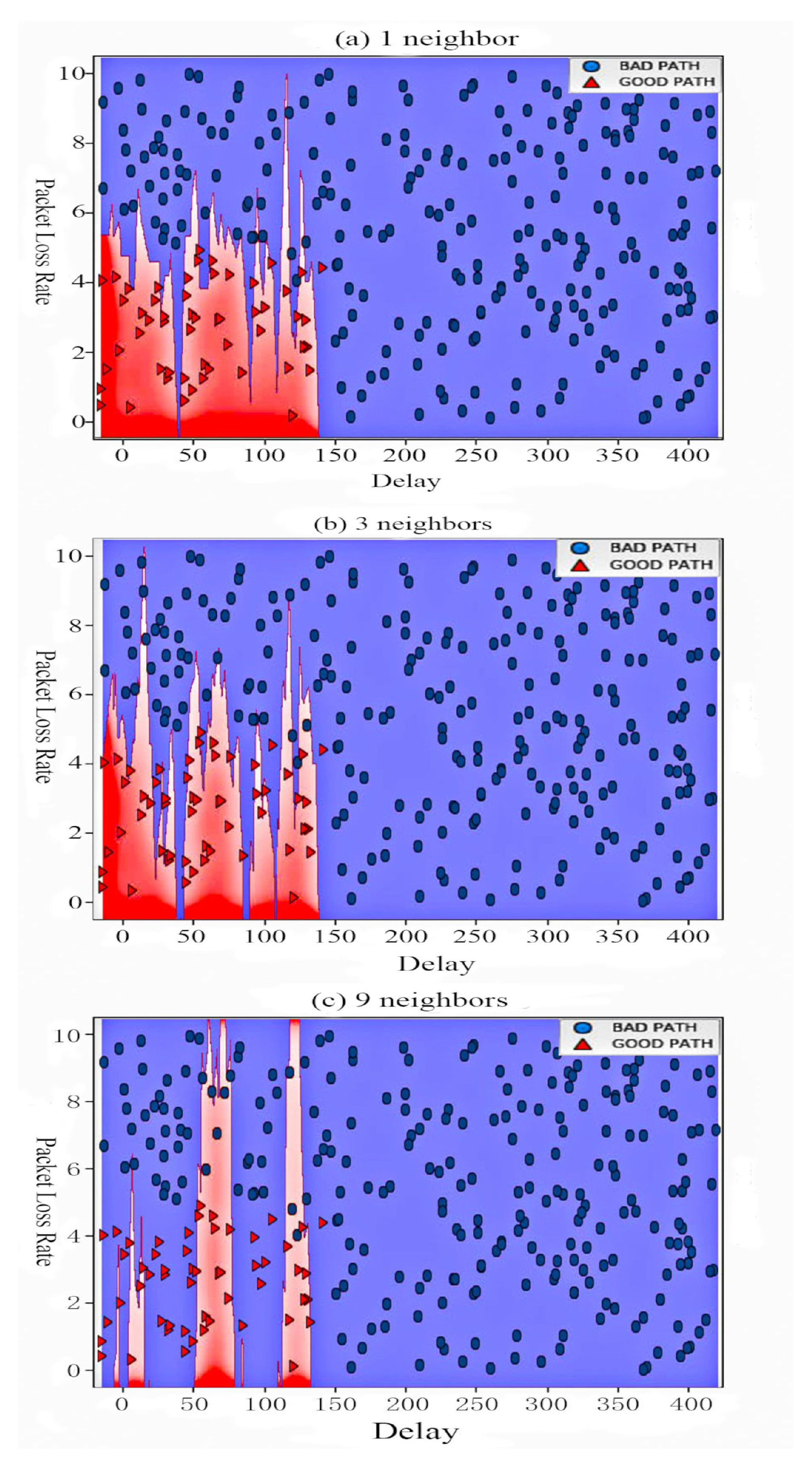
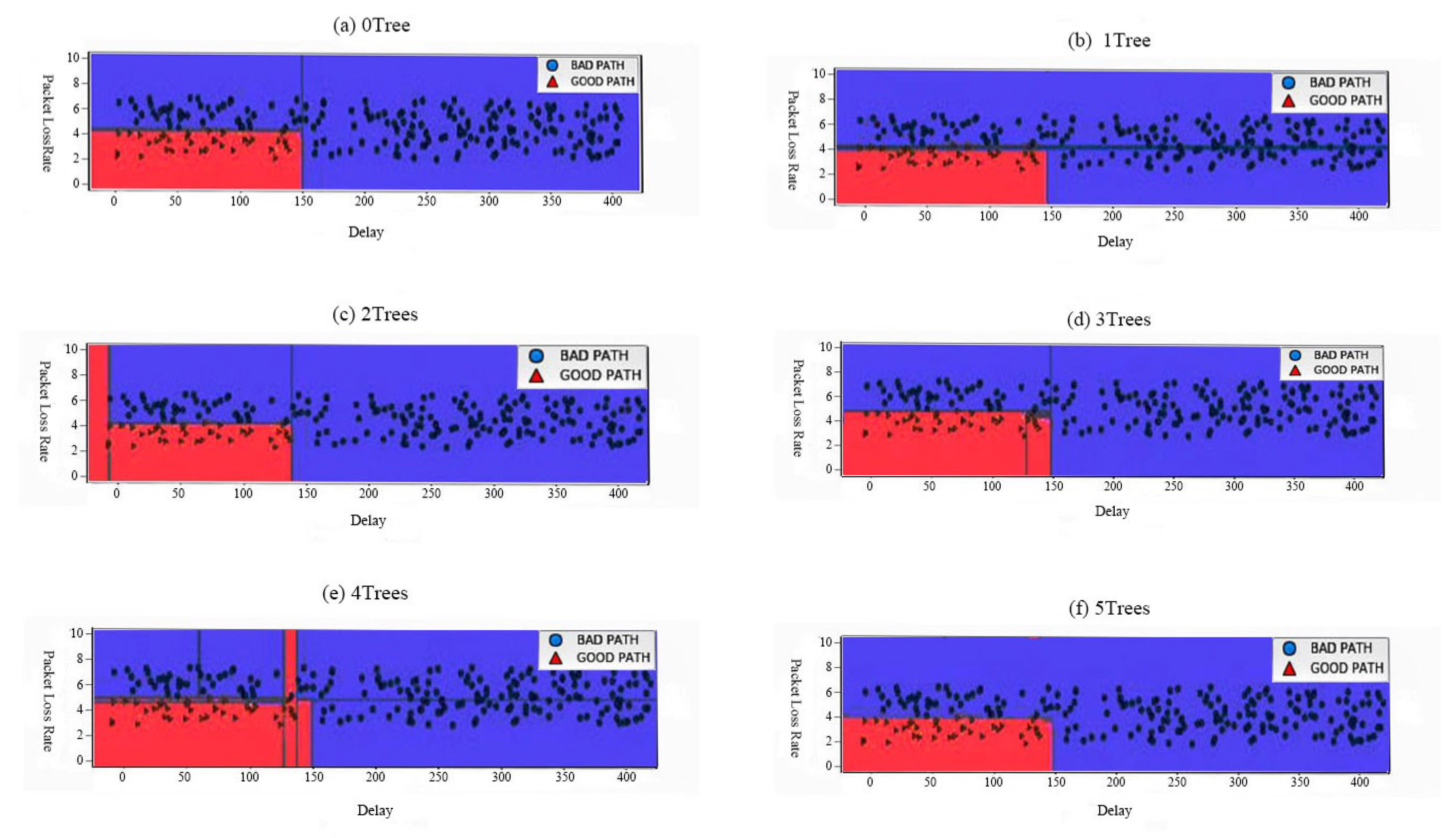
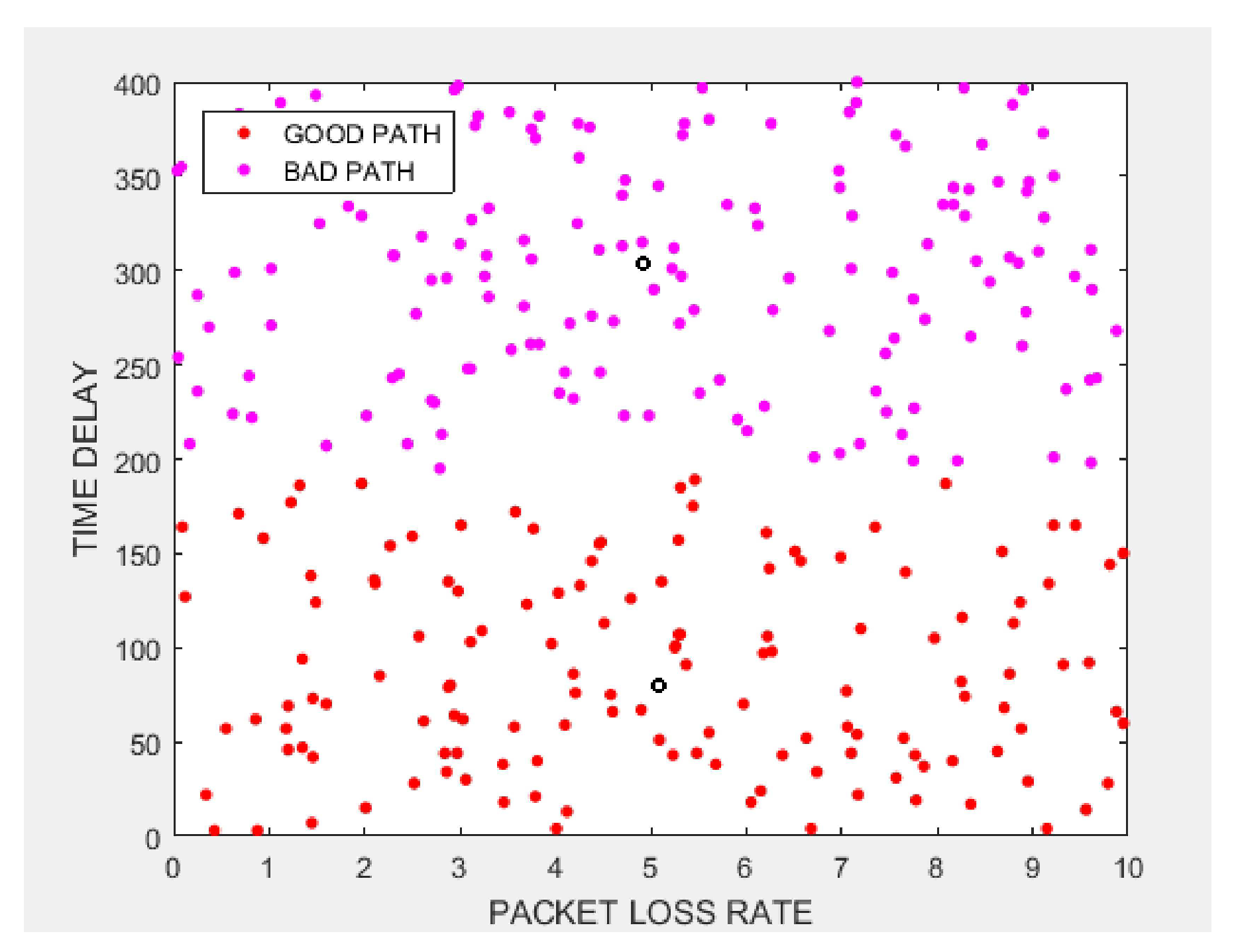
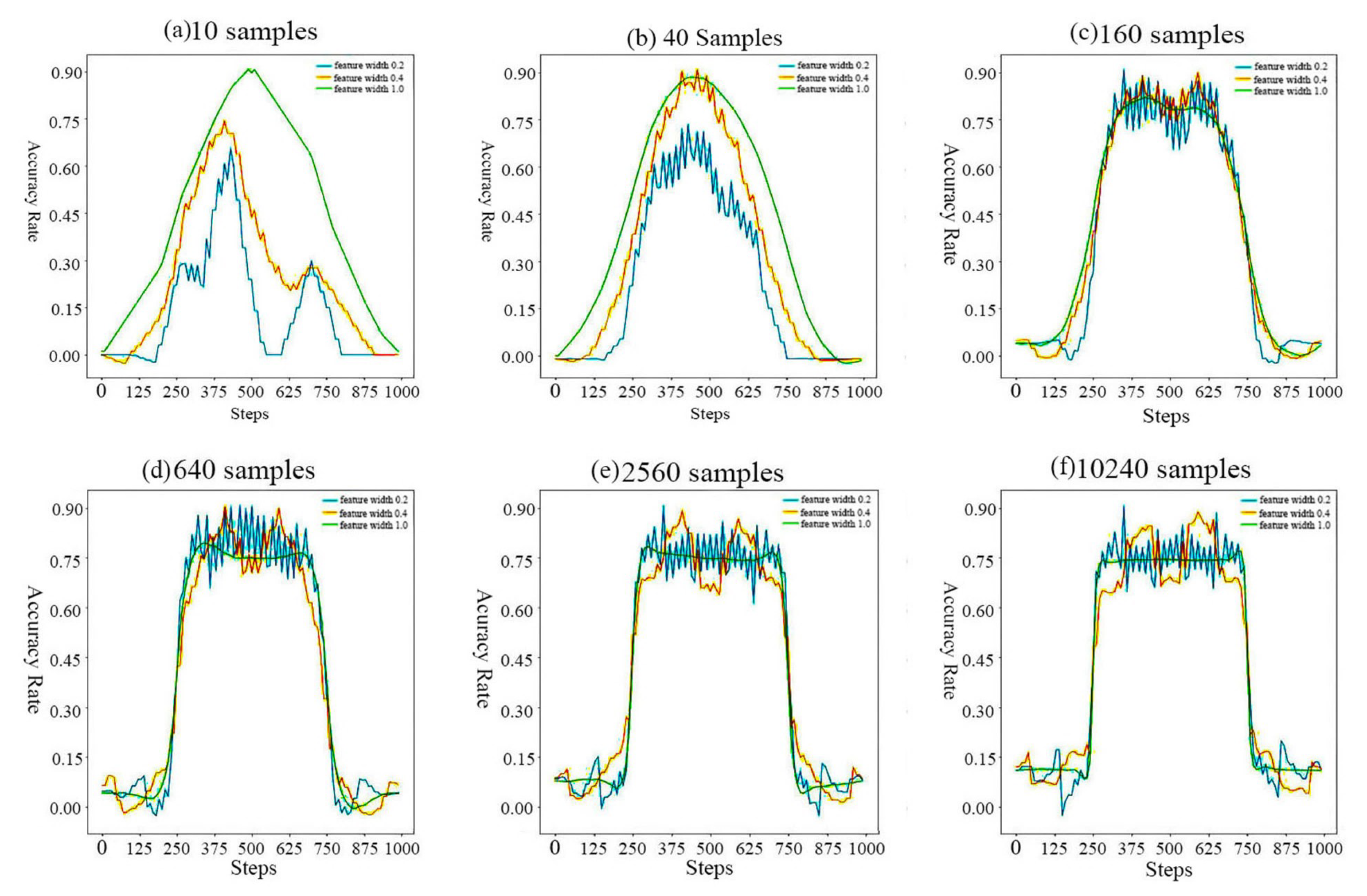

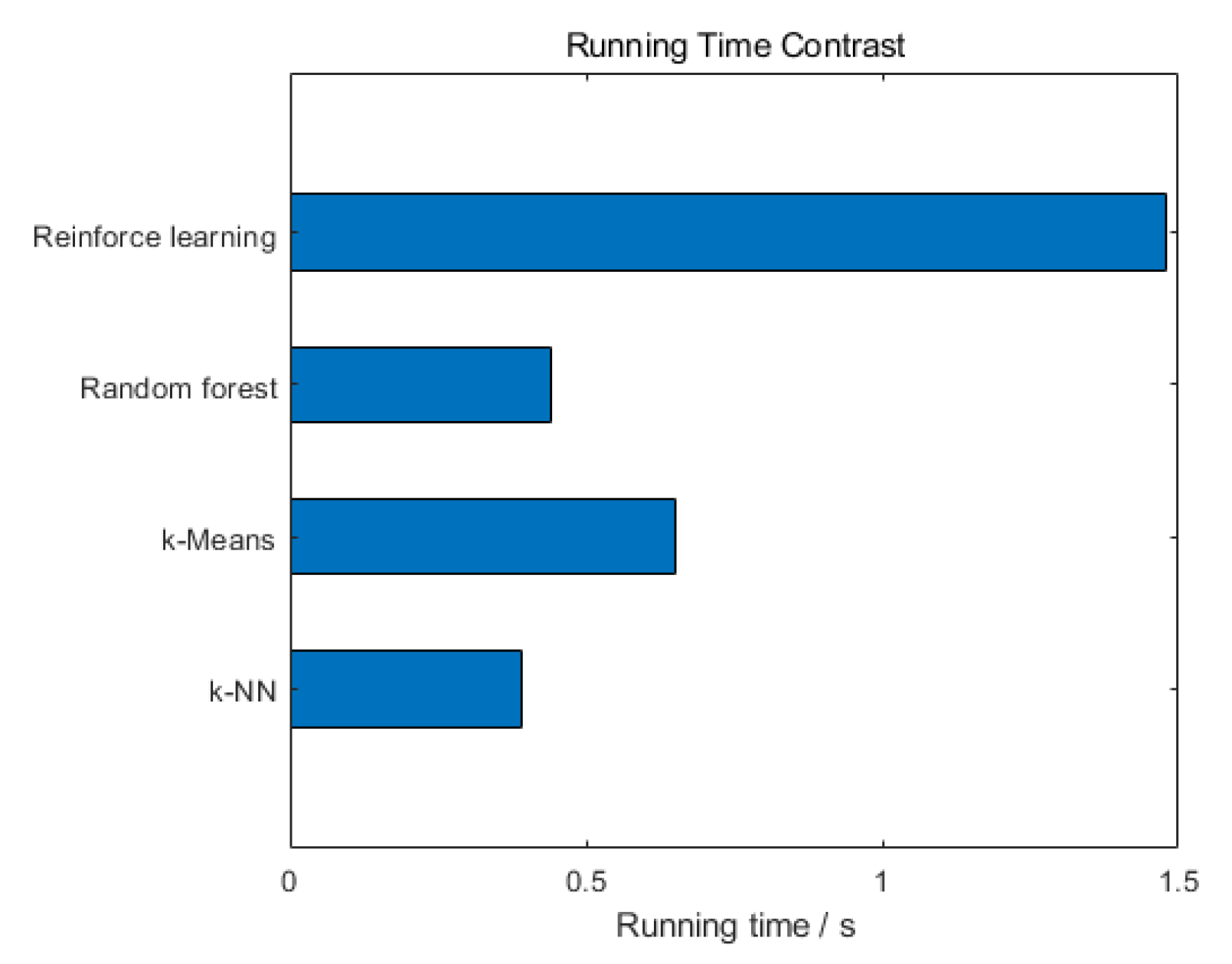
Publisher’s Note: MDPI stays neutral with regard to jurisdictional claims in published maps and institutional affiliations. |
© 2020 by the authors. Licensee MDPI, Basel, Switzerland. This article is an open access article distributed under the terms and conditions of the Creative Commons Attribution (CC BY) license (http://creativecommons.org/licenses/by/4.0/).
Share and Cite
Ji, R.; Cao, Y.; Fan, X.; Jiang, Y.; Lei, G.; Ma, Y. Multipath TCP-Based IoT Communication Evaluation: From the Perspective of Multipath Management with Machine Learning. Sensors 2020, 20, 6573. https://doi.org/10.3390/s20226573
Ji R, Cao Y, Fan X, Jiang Y, Lei G, Ma Y. Multipath TCP-Based IoT Communication Evaluation: From the Perspective of Multipath Management with Machine Learning. Sensors. 2020; 20(22):6573. https://doi.org/10.3390/s20226573
Chicago/Turabian StyleJi, Ruiwen, Yuanlong Cao, Xiaotian Fan, Yirui Jiang, Gang Lei, and Yong Ma. 2020. "Multipath TCP-Based IoT Communication Evaluation: From the Perspective of Multipath Management with Machine Learning" Sensors 20, no. 22: 6573. https://doi.org/10.3390/s20226573
APA StyleJi, R., Cao, Y., Fan, X., Jiang, Y., Lei, G., & Ma, Y. (2020). Multipath TCP-Based IoT Communication Evaluation: From the Perspective of Multipath Management with Machine Learning. Sensors, 20(22), 6573. https://doi.org/10.3390/s20226573






